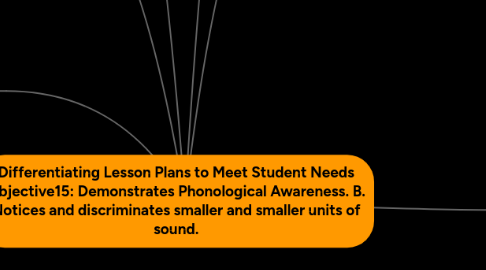
1. Learning Profiles- Students learn in different ways , therefore teachers should provide learning avenues for all students.
1.1. Connect: Connect syllables to everyday experiences the students hear in words used at home and in school.
1.1.1. Lower level Students
1.2. Content: Show students a cartoon video of the syllable game on PBS Kids.
1.2.1. Visual Learners/ELL Students
1.3. Summarize: Point out they key points that syllables are in every word we speak. Allow students to enforce what they have learned on an electronic device (tablet) word syllable game.
1.3.1. Autism
2. Readiness Levels
2.1. Students on grade/age level
2.1.1. Students work can be reinforced by pairing them in small groups of two or three where they can peer review each other's work. In this particular lesson the students can be in a student centered small group where they are given a task of sorting words by syllables and given a timer to make it a game.
2.2. Higher level students
2.2.1. Move on to the next task by asking higher level thinking questions which provoke complex thinking. Blooms Taxonomy questions are examples of what questions can be asked and what domains they belong to. Ex: "How could we", "How do you think", "What do you think would happen if"....
2.3. Lower level students
2.3.1. Give the student time to respond but also enforce what they already know and build classroom confidence when they are asked a question. Also give individual attention in lessons. In this lesson the teacher could set aside some time to thoroughly explain what syllables are and practice with those students each day individually until they have mastered the concept.
3. Strategies Used in Students with Autism
3.1. Kinesthetic Learners
3.1.1. Student could be a tactile learner and benefit from having hands on in an activity. Using a tablet to sort pictures will provide stimulation for multi sensory.
3.1.2. Give student the option of using a tablet for the lesson to keep them engaged in the lesson
3.2. Visual Learners
3.2.1. Giving the student a visual timer on a portable clock, timer, phone, tablet will give the student a visual countdown of when the time they should work on a task ends and they can take a break.
4. Strategies Used for Differentiation in ELL Students
4.1. Visual Learners
4.1.1. Provide students with visual aid along with verbal confirmation of the new language expressed to the student. Also give the student the same word in their native language for comparison purposes.
4.2. Solitary Learners
4.2.1. Provide independent learning activities for students to explore concepts within the lesson. set up an independent learning table for students to explore the syllable activity on their own.
5. Strategies Used for Differentiation in Lower Level Learners
5.1. Auditory Learners
5.1.1. Speak in slower speeds when instructing the student. Give verbal confirmation or praise when the student answers questions correctly. Ask student questions they already know the answers to and build the self-esteem and reinforce positive classroom view of themselves.
5.2. Kinesthetic Learners
5.2.1. Allow the student to use something tactile such as counters or engage in hands on activities in the classroom during lessons to help them learn as they are tactile learners and prefer to work with their hands.
